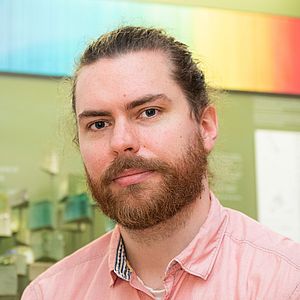
Photo: Deutsches Museum | Christian Illing
Natural Sciences
Academy Collection – the Founding Collection of the Deutsches Museum
In 1905, the Deutsches Museum received around 2,000 objects from the mathematics and physics collection of the Bavarian Academy of Sciences and Humanities. They remain the basis of our valuable collection to this day.
To mark the founding of the Deutsches Museum, the Bavarian Academy of Sciences and Humanities donated 2,023 exhibits to the new institution. These became the museum’s first exhibition pieces. The extensive mathematics and physics collection reflects the various facets of science, featuring instruments and apparatus for research purposes, as well as for education, teaching and entertainment. In addition, the exhibition pays tribute to individuals who rendered outstanding services to making these instruments – such as Georg Friedrich Brander, Georg von Reichenbach and Carl August von Steinheil. The most famous of these figures is most certainly Joseph von Fraunhofer (1787–1826), who set new standards in the construction of telescopes and surveying instruments. Following his discovery of the dark lines in the solar spectrum, he would go on to make important contributions to research into the physical nature of light.
Exhibition Themes
Fraunhofer display case. Solar spectrum with Fraunhofer lines. Drawing by Joseph von Fraunhofer, 1814. Photo: Deutsches Museum | Christian Illing
Solar Spectrum – Secret Code of the Stars
Even though stars are located many light years away, we know almost precisely their atomic composition and temperature. The Bavarian optical lens maker Joseph von Fraunhofer would lay the foundations of spectral analysis in 1814, using prisms, gratings and a converted surveying instrument to study the spectrum of the sun. When sunlight hits a glass prism, the different wavelengths of light are refracted by different degrees. Projecting the light onto a screen creates a band of colours – just like the colours of a rainbow. The colour band is interrupted by a multitude of black lines – also known as the spectral or Fraunhofer lines. These black lines are created when light emitted by the sun interacts with the star’s gaseous atmosphere. Spectral analysis is used to determine the temperatures and gas composition of the sun and other stars.
Nine-inch telescope produced by Joseph von Fraunhofer, around 1826/1827. The refractor (telescope) used by astronomer J.G. Galle when he discovered the planet Neptune in Berlin in 1846. Photo: Deutsches Museum | Christian Illing
Fraunhofer’s Telescope – where Glass is more than just Glass
Astronomical telescopes made it possible to observe the night sky more clearly. However, the lack of glass of sufficient quality placed major constraints on the construction of effective refracting telescopes. It was Joseph von Fraunhofer who succeeded in solving this problem. In the course of systematic studies, the Bavarian optical lens maker analysed the physical properties of glass.<br/> He used his findings to produce larger and higher quality lenses for telescopes. The optical glass was manufactured in the glassworks in Benediktbeuern, near Munich. Another of Fraunhofer’s achievements was the improved measurement of refractive indices of different types of glass. This made it possible to produce lenses with diameters of 20 to 30 centimetres. Lenses of this size were used in the telescope shown here – also known as a refracting telescope – designed by Joseph von Fraunhofer. It was one of the best telescopes of its time. It uses a clockwork mechanism to slowly track the starry sky as it moves above us. One of the two telescope mounts is aligned with the earth’s axis, making it possible to constantly observe a specific point in the sky. In 1846, this telescope was even used to discover the eighth planet in our solar system – Neptune. Joseph von Fraunhofer did not live to see the refractor in its final form. He died in Munich in 1826 at the age of 39.
Mass of rock crystal. Photo: Deutsches Museum | Christian Illing
Mass of Rock Crystal – One Kilo of Gemstone
The standardisation of measurements was already a topic of discussion as far back as the French Revolution. One idea at the time was for one kilogram to correspond to the mass of one cubic decimetre of water at five degrees Celsius. Another suggestion was to derive a kilo from the prototype metre. Decades later in the mid-1830s, Bavarian scientist and curator Carl August von Steinheil travelled to Paris. His mission was to replace Bavarian measures with French ones. The Parisian kilogram was made of metal – but oxidation and loss of material during cleaning could change its weight. Steinheil therefore used a reference kilogram made of rock crystal. With elaborate comparative measurements, he approximated its weight to within 0.05 milligrams of the original metal used by the French. Steinheil hoped that rock crystal would not be subject to weight fluctuations and would be cheaper to produce. Both proved to be false assumptions. Nevertheless, Steinheil’s successors implemented the new method successfully. The prototype kilogram would not be finally defined until 1889.
Facts
- Approx. 200 sqm exhibition area
- Around 250 exhibits
Any Questions?
![]()
M.Sc. Eckhard Wallis
Acting curator
Deutsches Museum
80306 MunichTelephone +49 892179 350
Fax +49 892179 99350
Email e.wallis@deutsches-museum.de
Do you have organizational questions?
Cornelia Schubert
Assistance to department heads, main department heads and curators
Susanne Schmölz
Assistance to department heads, main department heads and curators

